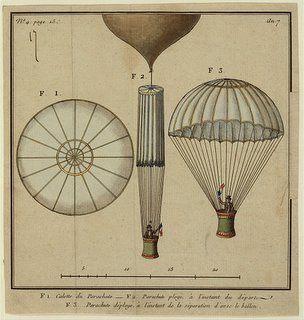'Advertisement for aeronaut and balloon manufacturer Henri Lachambre shows a balloon "H. Lachambre" with two passengers floating through a scene of animals, circus performers, and toy balloons.'
Lithograph ~1880
 [Aerialist wearing wings strapped to his shoulders
[Aerialist wearing wings strapped to his shoulders and feet while suspended from a balloon]
Woodcut ~1885
 Aérotère
Aérotère'Print shows a boat-like vehicle on wheels with parachutes'
Lithograph by H Francois sometime in 19th century
'French cartoon shows a man riding on a bicycle-like flying machine while looking through a telescope attached to the front. Two balloons, "Veloc[ipedes]" and "Domanie," are attached at front and rear as are propeller-like wheels.'
Lithograph ~1870
'Italian political cartoon shows a large balloon ("Politica") in the shape of a man ready to gobble up the moon ("Oriente") defended by a man ("Turco") holding a fork. Other armed men representing the nations of Europe and North Africa are falling off the balloon into the frying pan of war ("Guerra") held by the Roman god Mars ("Marte").' from Papagallo 1880
 Navigation aérienne
Navigation aérienne'Ballon & appareil de direction construit par M. Pompéien-Piraud, inventeur'
Wood engraving print by B Arnaud 1883
'Technical illustration shows early balloon designs: "Lana's aeronautic machine," Montgolfiers' balloon," "Blanchard's balloon," "Garnerin ascending [and] descending" in his parachute, the "Charles & Roberts' balloon" being inflated, the "form of the wings employed by Lunardi," and the "form of the wings employed by Blanchard." ' [detail: 'form of the wing' missing here]
Drawn by Joseph Clement ; engraved by A.W. Warren & J. Davis. 1818
 Le premier parachute de Jacques Garnerin, essayé
Le premier parachute de Jacques Garnerin, essayé par lui-même au parc de Mousseaux, le 22 octobre 1797
 Captive balloon with clock face and bell,
Captive balloon with clock face and bell, floating above the Eiffel Tower, Paris, France
Watercolour over graphite by Camille Grávis
The Tissandier brothers, Gaston and Albert, assembled a collection of more than 900 items relating to the early history of aeronautics from various sources. Gaston Tissandier (1843-1899) was a balloonist and science writer. Albert (1839-1906) was a balloonist and illustrator.
"Subjects include general and technical images of balloons, airships, and flying machines; portraits of famous balloonists; views of numerous ascensions, accidents, and world’s fairs; cartoons featuring balloon themes; pictorial and textual broadsides; and colorful ephemera and poster advertisements. There are also several hundred illustrations clipped from books and newspapers. The pictures, created by many different artists, span the years 1773 to 1910, with the bulk dating 1780-1890."
"The collection is rich in images of flights the Tissandier brothers participated in as well as flights they observed between 1865 and 1885. For example, Gaston Tissandier flew over enemy lines during the Siege of Paris in 1870, and Albert made drawings of several balloons that were used to carry passengers and supplies over enemy lines. While Gaston tested the limits of balloon ascension, Albert made drawings of natural phenomena in the upper atmosphere." Together in 1883 they rigged up a Siemens electric engine to an airship and Gaston became the first person to use electric-powered flight.
Gaston, who was a chemist and meteorologist (hence his interest in balloons) and wrote many books, also established the scientific magazine La Nature in which many of Albert's lithographic illustrations were published.
- 450 items from the Tissandier collection have been digitized and posted by the Library of Congress (thumbnail page).
- Background and scope of the collection.
- Biography of Gaston Tissandier.
- Gaston Tissandier at Wikipedia.
- Works by the brothers at Project Gutenburg.
- Previous entries: Tissandier's America & Revisiting Albert Tissandier. Camille Flammarion; Passarola; Albert Robida.
- Complete copies of La Nature between 1873 and 1905 at Le Conservatoire Numérique des Arts & Métiers.
Engraving by J Belbing 1807
[I removed some background artifact from a couple of images here]















































3 comments :
love love love love love.
you my friend are a tireless champion among bloggers and i appreciate it.
My childhood mania for flying-machines of all kinds has long subsided, but there’s something about balloons that still does it for me. If you’ll excuse a supplementary self-link, I found the amazing story of the Zénith by way of the Tissandier collection.
And, what jmorrison said!
Thanks lads!
And thanks for the link misteraitch - I had seen a snippet in passing about the deaths on that flight and didn't pursue it. Powerful story indeed.
My mania for the airborne didn't start 'til adulthood - I find illustrations of the old 'potential' vehicles the most fascinating.
Post a Comment
Comments are all moderated so don't waste your time spamming: they will never show up.
If you include ANY links that aren't pertinent to the blog post or discussion they will be deleted and a rash will break out in your underwear.
Also: please play the ball and not the person.
Note: only a member of this blog may post a comment.